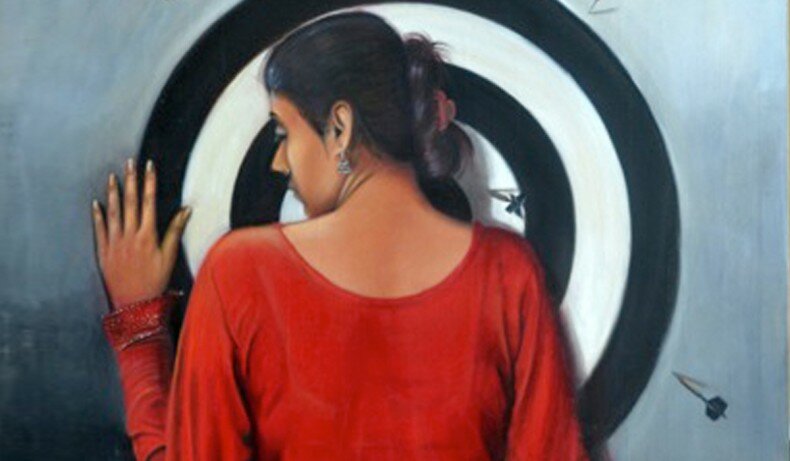By Ayesha Majeed –
Zarmeena and Sumera showcase their talent revolving around fragile feelings of fairer sex at Ejaz Art Gallery
“Some research suggests that women are often better at articulating their feelings than men because as the female brain develops, more capacity is reserved for language, memory, hearing and observing emotions in others.” (An excerpt from article of New York Times)
 Reading this I know most of the male artists would contradict (and they are right! in a sense) But somehow these line are doing justice with the exhibition under review. It can also be called a feminist show of feelings. Titled “Dedicated To You” the exhibition opened at Ejaz Art Gallery Lahore On Tuesday June 9 by two female artists Zarmeena Aslam and Sumera Jawad.
Reading this I know most of the male artists would contradict (and they are right! in a sense) But somehow these line are doing justice with the exhibition under review. It can also be called a feminist show of feelings. Titled “Dedicated To You” the exhibition opened at Ejaz Art Gallery Lahore On Tuesday June 9 by two female artists Zarmeena Aslam and Sumera Jawad.
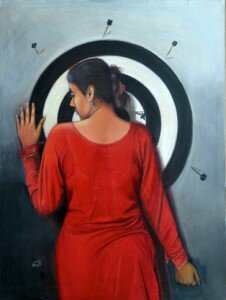 In a magnificent way both of the artists touched the topic of cultural feminism built on racial, sexual and spiritual platforms. The show is devoted purely to the sensitive, fragile feelings of the fairer sex who by evolutionary design is hard- wired to be sensitive to her surroundings. The social implications imposed on her, what she feels inside and in fact the joys and sorrows of being a woman is portrayed by the artists on the canvas. It’s like an artistic “movement” to vent out all that is bottled up inside.
In a magnificent way both of the artists touched the topic of cultural feminism built on racial, sexual and spiritual platforms. The show is devoted purely to the sensitive, fragile feelings of the fairer sex who by evolutionary design is hard- wired to be sensitive to her surroundings. The social implications imposed on her, what she feels inside and in fact the joys and sorrows of being a woman is portrayed by the artists on the canvas. It’s like an artistic “movement” to vent out all that is bottled up inside.
The work of Zarmeena Zubair revolves around the images of theater performers. As the artist opines that once she attended the theater performance and out of curiosity she visited the artists at the back stage. By doing so she realized how much hardship a theatre performer actually faces being a woman. She calls them “divine beauty” that should be respected by the society. Artist thinks that “they” are more emotionally strong as compared to other women of society, because they face “ugly stares” of the audience, foul comments, harsh behavior and in fact bullying by every one yet they pretend to “show off’ a pretty, smiling face.

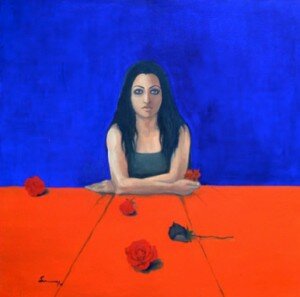 In a canvas titled “She the Weaver” a “performer” is shown sitting may be at back stage playing with her thoughts and weaving a mask that she would wear while on the stage to perform. It’s kind of “hit-on-face” message to the society .The symbol of white thread is used very elegantly to represent her “thoughts weaving process”. The fine folds of her drapery and the anatomy of the figure are beautifully rendered.
In a canvas titled “She the Weaver” a “performer” is shown sitting may be at back stage playing with her thoughts and weaving a mask that she would wear while on the stage to perform. It’s kind of “hit-on-face” message to the society .The symbol of white thread is used very elegantly to represent her “thoughts weaving process”. The fine folds of her drapery and the anatomy of the figure are beautifully rendered.
Another canvas titled “Being Hitting” is also a message to the society which normally ill treats stage performers. Here a figure is shown from the back that s wearing bold red colored dress which is in contrast to what is happening inside her heart. The arrows and the marked field are like brutal “stabs” by the society on her heart in the form of ugly stares and foul words. She is trying to look, what she is not! The same message is conveyed in a canvas titled “Blind Folded” where a woman is shown wearing a red dress to make her pretty, charming but she has covered her eyes with a cloth as if she cannot bear the stares of the people sitting as audience. An ironic symbol of three hanging masks is used as she as a performer would wear it according to the demand of the situation. The black used in the background is like darkness prevailing in her life. Mostly grey, black, bright red and yellow are prominent in Zarmeena’s work.
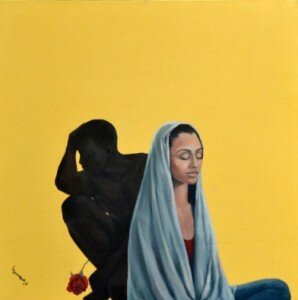
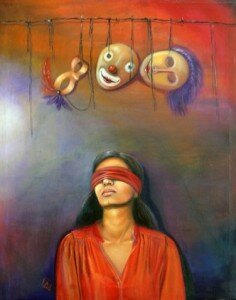 Sumera Jawad’s work depicts an ensemble of female and rose as quintessential to each other. As to the artist “the rose and a female share fragile folds and fantasies which complement each other with similes and metaphors of purity, virginity, seduction, secrets, sexuality, fertility and regeneration.”
Sumera Jawad’s work depicts an ensemble of female and rose as quintessential to each other. As to the artist “the rose and a female share fragile folds and fantasies which complement each other with similes and metaphors of purity, virginity, seduction, secrets, sexuality, fertility and regeneration.”
In her painting titled “Faith” woman’s feelings are depicted in a beautiful way .She is supposed to trust “blindly” on her male partner. With a cloth her eyes are tied for; “not to see”. A red rose which often symbolize passion, love, beauty and something of value is used as a symbol here. She is like a “brand new” rose that has just bloomed, which is not yet wilted by the heat or is turning brown. She is blindly following the path and is ignorant that her innocent soul has yet to experience all the hardships en-stored for her by life and its experiences.
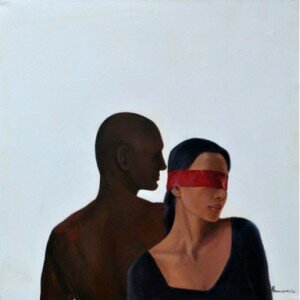
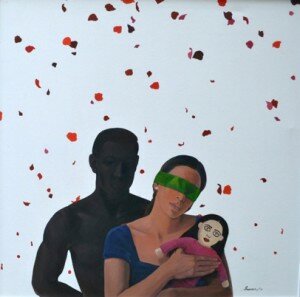 A black “shadowed” male figure is mostly seen in the background of Sumera’s paintings which can be taken as a symbol of male dominance in a woman’s life (who like a rose) is beautiful, pretty and adorn herself to please him. Just like a flower she has layers and layers to unfold what’s there inside her heart which is sensitive, fragile yet too strong to bear the burden of expectations, social implications and most of all the ignorance of her male partner.
A black “shadowed” male figure is mostly seen in the background of Sumera’s paintings which can be taken as a symbol of male dominance in a woman’s life (who like a rose) is beautiful, pretty and adorn herself to please him. Just like a flower she has layers and layers to unfold what’s there inside her heart which is sensitive, fragile yet too strong to bear the burden of expectations, social implications and most of all the ignorance of her male partner.
The canvas titled “Pick One” shows a woman staring into the eyes of the viewer, sitting isolated amidst bold colored background and foreground. Her blank yet bold stare reveal as if she is suppressing her emotions consciously and deliberately. She has to pick “one” for herself but she has no sense of “her choice” and judgment left.
 In Sumera’s paintings the symbol of rose can also be taken some where as the newness of relationship, a delight of a romance when everything seems fresh and new and too exciting. Ironically with the passage of time (a day of two) a rose opens its folds soon withers and dies. Sumera has used the symbol of rose as the “soon to die” relationship of a man and a woman. Her paintings titled ‘Rose 08’, ‘Duplicity’ and ‘Flower’ seem to convey the same message.
In Sumera’s paintings the symbol of rose can also be taken some where as the newness of relationship, a delight of a romance when everything seems fresh and new and too exciting. Ironically with the passage of time (a day of two) a rose opens its folds soon withers and dies. Sumera has used the symbol of rose as the “soon to die” relationship of a man and a woman. Her paintings titled ‘Rose 08’, ‘Duplicity’ and ‘Flower’ seem to convey the same message.
One can conclude that both the artist used an artistic way of releasing pent up emotions with bold colors and a remarkable study of anatomy.
The writer is a Lahore-based artist, art critic and educationist





















































































